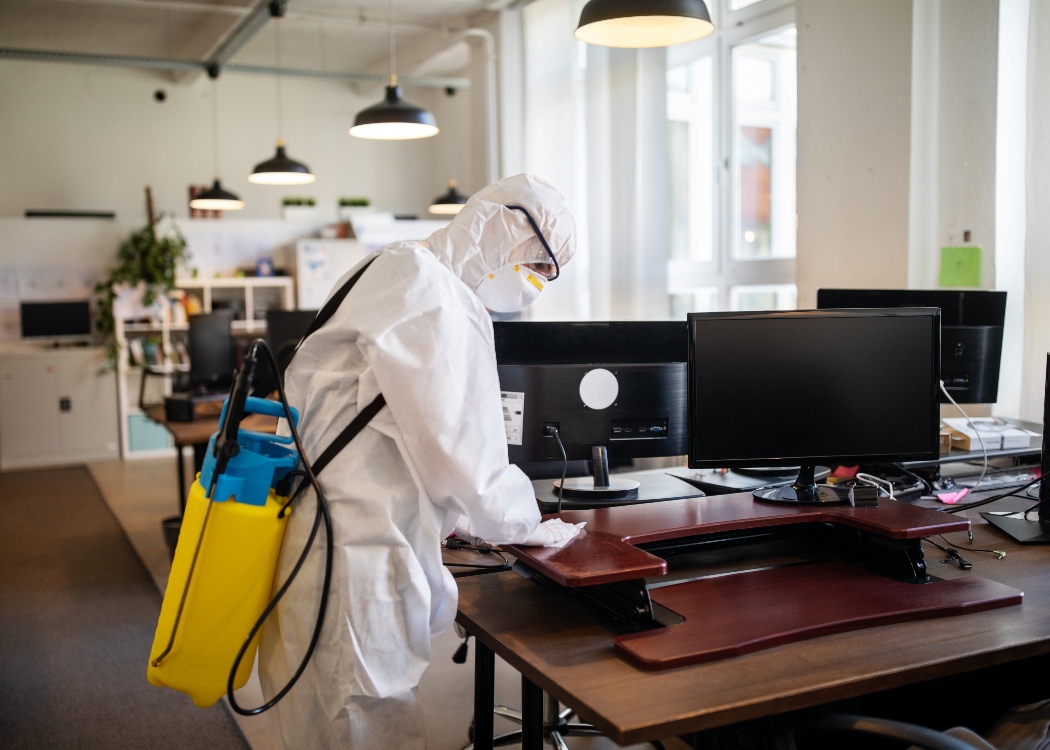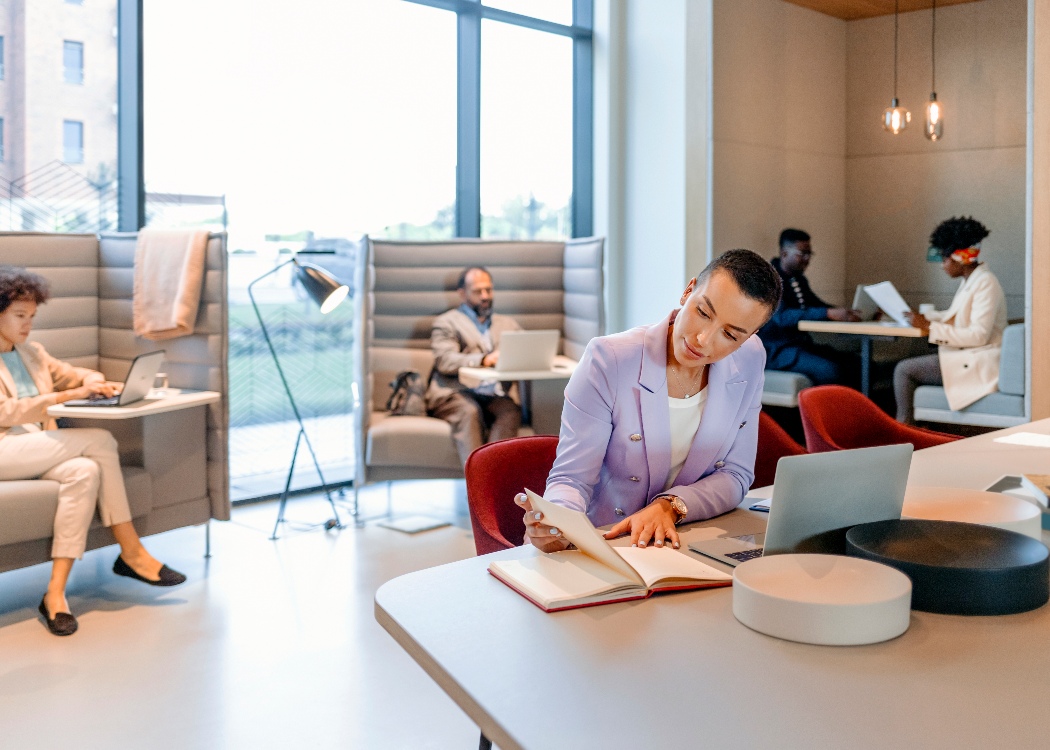
Let us help you with finding an office space
Our experts are here to help take the hard work out of finding your next office space.

Initially, employees can be wary of hot desking, but it can be a very effective flexible workplace strategy that’s a great fit for agile working environments in all sorts of industries. In this quick guide, we’ll explore the ins and outs of hot desking, outline the pros and cons and discuss why some employees are lukewarm on this increasingly popular practice.
Hot desking is a workplace practice where employees don’t have designated desks that they sit at every day. Instead, desks are available on a first-come, first-served basis, which means employees and teams can be sat in different places from one day to the next.
Hot desking has become increasingly popular over the last few years as more companies have adopted hybrid working models. Primarily, businesses turn to hot desking for practical reasons. With fewer people travelling to the office every single day, it doesn’t make sense to have a large office space where every person has a dedicated desk. Instead, it’s better to provide fewer desks and implement a hot desking policy where desks are shared.
If it’s managed with care, this workspace sharing model can maximise efficiency and decrease overhead costs. It can also help to foster collaboration and creativity between your teams, as departments become naturally entwined. The flexibility and practicality of hot desking make it a common seating model for agile and hybrid workplaces, so it’s worth considering for many employers.

Hot desking helps you use your office space more efficiently, so it’s fuller more of the time. By removing assigned desks from the floor plan, you can reduce your capacity and square footage requirements.
With a smaller office space comes lower costs. By implementing hot desking in your business, you can reduce your office space and scale up organically, when you’re ready and need the space. The overheads are typically cheaper, too, allowing you to invest your finances elsewhere.
Sitting at a different desk every day gives employees the chance to get to know colleagues they may not usually talk to. This can promote teamwork, build new connections and improve cross-departmental collaboration. Workers can also sit next to their bosses, helping to break down barriers and make the workplace feel more equal.
Hot desking is core to the switch to modern hybrid working, where more agile and flexible working practices are commonplace. Having fewer desks and encouraging hot desking takes away the unhealthy stigma of presenteeism. Instead, employees choose where they can do their best work, and use the desks as and when they need them.
For some employees, the connections they have with the colleagues they sit next to are very important. Constantly switching up this seating plan can make it difficult to form lasting friendships, which can make employees less happy at work and lower morale.
The physical separation from team members and managers can leave some employees feeling unsupported and unseen. It can also be difficult to find colleagues easily when they need help.
Not every employee has the same technological needs. While creative teams may benefit from high-resolution screens and powerful graphics cards, data-based workers may need desktop computers with multiple screens for analysis and comparison. Deciding which desks will have a desktop computer and which workers will have to bring laptops can complicate things.
Having fewer people in the office is good from a health point of view, but having different employees using the same desk on consecutive days is not. With COVID-19 still lingering, hot desking equipment will need daily disinfecting to keep the workplace safe.

Switching to hot desking is a big cultural change and, as we’ve discussed, can negatively impact the workplace environment. That’s why it’s so important to discuss the move with employees long before it happens and get them involved in the practical application of your hot desking set up every step of the way.
Here are some of the steps you can take to make hot desking work for your business.
Think about what your employees’ daily interactions with your hot desking facility are going to look like. For example:
Discuss the benefits of hot desking for employees and the business openly, and clearly explain how the system will work. Inviting people to respond and raise their concerns will help make the change easier for many individuals and highlight any issues you may not have thought of.
For your hot desking policy to work, employees need to embrace the agreed upon system and benefit from the agility and flexibility it affords. Part and parcel of this is identifying exceptions in advance - some roles or departments require the same desk regularly or even permanently. As above, communication is key.
There’s more to hot desking than just desks. Different people like to work in different ways, so you should create an agile working space that suits them and the activities they’re doing. Booths for quiet, deep focus, couches for one-to-one meetings and social spaces for collaborative working can bring more flexibility to the office and make it an attractive place to work.

For some people, hot desking can be a hassle. As they no longer ‘own’ a space, they have to carry their laptops, paperwork, stationery and any other personal belongings, like mugs, around with them. You can easily overcome this inconvenience by providing lockers and other secure storage solutions where employees can leave their things.
You’ve got to be careful about making your hot desking policy too rules-based, but it’s well worth putting a few basic etiquette pointers in place. Provide guidance on where staff can store personal items and rules for cleaning the hot desking equipment once they’re finished for the day - and if applicable, how and when to book a desk.
If hot desking is going to work for your business, you need to put the right tech tools in place so employees can collaborate with their colleagues whether they’re on the other side of the office or working from home. Desk booking software, real-time office maps and workplace mobile apps are all tech solutions that can simplify your hot desking facility.
If you want to discover the benefits of hot desking for your business, you need a workspace that can accommodate this type setup. Flexible office solutions, like Coworking spaces, serviced offices and managed offices, are perfect, as they all provide the flexibility to adjust your requirements as you learn what does and doesn’t work for your business and your people.
Coworking spaces often come with options for a dedicated desk or a hot desk in a shared office on the most flexible terms.
A serviced office gives you a private office and shared amenities within a larger workspace. Here, you buy into the office experience that the provider defines, so you may not be able to redesign the space to create an agile working environment. However, the way you assign your desks is up to you. By hot desking, you could save money by reducing the size of the serviced office you need, then scaling up or down from there according to your business’ needs.
A managed office space still provides more flexibility than a conventional lease, yet it gives you more scope to customise the space around your needs when compared to a serviced office. You can include hot desks, assigned desks, agile working environments or a combination of all the above to suit your requirements.
At Knight Frank, we can help you find the perfect hot desking solution. Whether it’s a coworking space or a serviced or managed office, we know the London office space market inside-out. Just tell us what you’re looking for, and we’ll arrange and attend the viewings on your behalf. We’ll even negotiate for you to help you get the best deal - and what’s more, we’ll do it all for free.
Get your monthly dose of workplace insights, productivity hacks and business leadership ideas - delivered straight to your inbox.

Our experts are here to help take the hard work out of finding your next office space.